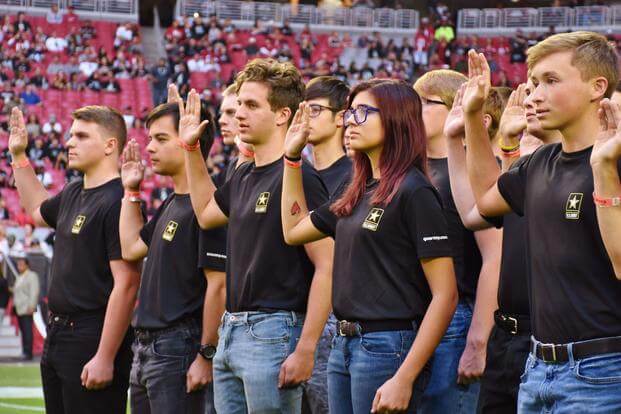The opinions expressed in this op-ed are those of the author and do not necessarily reflect the views of Military.com. If you would like to submit your own commentary, please send your article to opinions@military.com for consideration.
Taren Dillon Sylvester is a researcher at the Center for a New American Security.
Despite 50 years of an All-Volunteer Force, fear of conscription remains just below the surface as Americans consider the role of the U.S. military and their relationship to it. Today, whispers of conscription ripple across social media whenever it seems that the United States might be drawn into a conflict -- after the 9/11 terrorist attacks; when Iranian Gen. Qasem Soleimani was assassinated; and following the 2022 Russian invasion of Ukraine. Google searches for the "draft" spike following these events like clockwork.
However, despite what Americans experienced in the 20th century, the United States does not have a long tradition of conscription. In fact, conscription goes against the deeply held values of individual liberty and equality prized by Americans across the political spectrum.
A better understanding of what modern conscription looks like in practice and what it would take to implement the draft in America today would increase Americans' trust in the military as a whole and contribute to healthier civil-military relations at all levels of society.
How militaries are staffed looks different across the world. Broadly, military recruitment models can be categorized in one of three ways: voluntary, limited conscription or full conscription.
A voluntary recruitment model is centered on a small, professionalized force composed of individuals who serve willingly. Many nations rely entirely on volunteers, including two of the world's largest military forces: the United States and India. However, most countries with volunteer armies at one point relied on conscription. The decision to transition to an all-volunteer force tends to coincide with a military drawdown at the end of a conflict, as was the case in the U.K. following World War II, the United States after the Vietnam War and Belgium following the end of the Cold War. For others, defense budget constraints were the driver. For example, Germany only did away with its mandatory service in 2011 due to economic pressures.
In contrast, countries that conduct limited conscription require all eligible citizens of an age group (usually 18) to register for conscription, but then only draft a small subset of that population into service. This model is often used by states that struggle to meet force readiness quotas. Others use conscription as a means of strengthening equity and civic engagement through the random selection of draftees across all strata of society. Mexico, for example, has historically used randomly drawn colored balls to determine conscription status (black for deferred, white for conscripted and blue for naval service). The draft in the United States in the 20th century was likewise a limited conscription system. Service was determined by randomly drawn birthdates. Norway is unique in that while every man is required to register for the draft, only the most fit and qualified are selected for conscription.
The final military recruitment model is full conscription. In nations with full conscription systems, every man is required to both register and serve in the armed forces by a certain age. Citizens also often remain in the nation's reserve forces after their initial service period expires. In some countries, like Switzerland, military conscription acts as universal military training lasting anywhere from a few weeks to a few months. Many of these kinds of militaries can be characterized as professional volunteer forces that, in theory, can rapidly scale up to face emerging threats, if necessary. For others, conscripts serve for more than a year and are placed into units within the nation's formal military. Countries like South Korea and Finland, for example, have made headlines in recent years by recalling internationally famous musicians and athletes to return home to complete their military service.
There are pros and cons for each staffing approach. One considerable advantage that conscription offers is better integration of the military and the general public. Close ties between civilians and the military foster trust in the institution by linking the fate of the military with that of the country at large. Drawing on all sectors of society to serve together helps to prevent a military elite from rising to power, independent of the will of the people. Healthy civil-military relations increase civic participation and help stabilize societies.
But at the same time, military conscription is not always applied fairly across a given society. For example, before the transition to a volunteer force, conscription in Germany pulled heavily from the former Soviet-aligned eastern states. Similarly, in Russia and China, conscription is still more heavily enforced in rural areas, compared to urban. In the United States, inequality among those who received deferments and conscientious objector status was a key driver of resistance to the draft during the Vietnam War and ultimately heralded the transition to an all-volunteer force. In all these nations, the bulk of military recruits today are still pulled from geographic locations that historically produced many draftees.
Another issue with conscription systems is the expense and the bureaucratic burden required. To enable an effective conscripted force, a nation must be able to train and equip draftees. In 2021, the United States had 30 million people aged 18-24. However, Department of Defense 2022 recruitment goals for both active and reserve components across the services targeted 104,540 new troops, an order of magnitude smaller than the total population. Even granting increasing numbers of enlistment waivers, they struggled to recruit, train and equip those forces.
The cost in both dollars and hours needed to train an entire birth year of citizens is enormous. Some nations attempt to balance these costs by making conscription service unpaid or severely underpaid. Overcoming both pay inequality between draftees and civilians and the loss of career opportunities that conscripts endure is a major challenge for an all-volunteer force..
Given the major drawbacks of conscription as a military recruitment model, an all-volunteer force is the only option Americans will tolerate, except in the event of an existential threat to the U.S. homeland. While some countries must resort to conscription because they feel that they live in the shadow of such a threat, the United States is fortunate in its physical security, flanked by two oceans and friendly neighbors that possess neither the desire nor capacity for invasion. U.S. citizens' choice to participate in military service is protected not only by the nation's values, but also by the confidence afforded by its global leadership position.
Choice and self-determination are fundamental to the great American democratic experiment. But confusion surrounding the relationship between U.S. national security and individual liberty or choice has left many Americans out of touch with what the military is, does, can do and should do.
The solution to this widening divide between the civilian and military worlds is not, as some argue, forced conscription in a misguided attempt at equal service. Rather, the Department of Defense must work to reestablish young Americans' trust in the military as an institution by showing the value of service members to the country and value of the military to local communities. The first step in building trust is reckoning with the personnel failures that disenfranchise current and former service members, like poor quality of life in barracks, the sexual assault crisis and rising extremism in the ranks.















